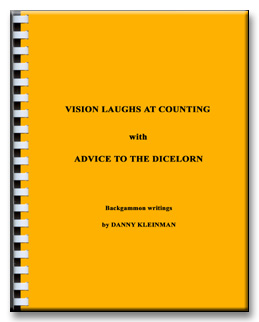| |

|
Vision Laughs at Counting
Danny Kleinman
1980, 438pp
|
Note: The latest editions have been revised with modern board diagrams, which corrects a major deficiency in the originals.
The two volume Vision Laughs at Counting set is my favourite backgammon book (I bought it twice, just for the benefit of the revised board positions). Kleinman is arguably the most knowledgable deep theoretician of the game, and his dynamic prose never fails to keep the reader entertained. At $80 for the set, Kleinman's wisdom doesn't come cheap, but money players will soon find that their investment is recovered many times over, from careful perusal of the text.
Kleinman's forte is chouette play and much of the first volume focuses on chouette strategy and tactics; including the mechanics of play and the deeper psychology of the game and money management. The author takes a theme, for example "Killing and maiming numbers" — describes and explains the theory and illustrates the concept by reference to problem positions. The lesson is reinforced in humorous vignettes which take the form of letters to Miss Lonely Blots (Kleinman's alter-ego) from a motley crew of fictious backgammon stereotypes, "Frankie Fiveroller," "Seymore Sykologist," etc.
As hinted by the title, Kleinman's magnum opus is dedicated to the elaboration of the two major elements of the game — vision and counting. Kleinman teaches the reader to focus on the dynamism of the game and to assess the key priorities as the game unfurls. "At the highest levels, backgammon geniuses see what the rest of us can only struggle to figure out."
Often the advice is relatively simple — how to perceive the dice rolls (individually and in combination), "Don't reach for a checker until you decide where to move it. And don't play any of your numbers until you decide how you intend playing the rest." Further pearls of vision wisdom — "You must see the whole board ... you cannot sit scrunched up ... with your eyes focused on just one sector. Sit back comfortably where you can see it all ... Never let your opponent lean his elbow over a blot ... Don't leave your arm stretched out to grasp a checker or a a die, for that will obscure part of the board." Simple stuff, but vital information for the beginner (or intermediate) that seldom warrants mention in most backgammon texts.
Kleinman is a great teacher. He has the rare ability to frame complex technical issues in illuminating analogies which stick in the readers mind. For example, "The Chemistry of Anchors" assess the function and value of various anchor points — from the golden five-point to the iron ace-point. "The Anatomy of Primes" elaborates the important function of blockades by reference to dynamic prime fields, prime acreage and prime wilderness. Like many great teachers, Kleinman critiques the classics — the standard reference works of other experts — and sets out a concise summary of Magriel's Backgammon in just five illuminating pages.
Kleinman is perhaps noted most for his mathematical genius, and the author certainly has a gift for putting a number to every conceivable concept of the game. Readers fluent in mathematics will delight in Kleinman's essays on; "Backgammon as a Problem in Mathematics"; "The Prime Leaping Problem"; and "The Cube Equations", while the mathematically illiterate will benefit from countless numerical mnemonics, handy tips and hints.
The second volume contains extensive content on cube theory with reference to money games, chouette and tournament matches, amply illustrated with match equity tables, gammon price tables, and of course, lots of mathematical formulae. Kleinman signs off on a light note with a section on backgammon philosophy and humorous series of quizes which includes a test of the readers temperment and attitude for hustling.
Here's an overview of the content:
Volume 1
Welcome to the Chouette (30 pages)
Vision (67 pages)
Counting (26 pages)
Racing (49 pages)
Gammons (24 pages)
Volume 2
Cube (48 pages)
Tournament (44 pages)
Mathematicians Delight (23 pages)
Rules and Variations (13 pages)
Laughs (14 pages)
Quizzicale (56 pages)
In summary, if I could only keep one backgammon book then this would be the one. What's that I can't count both volumes as one? Hmmm tough choice then.



![]()
